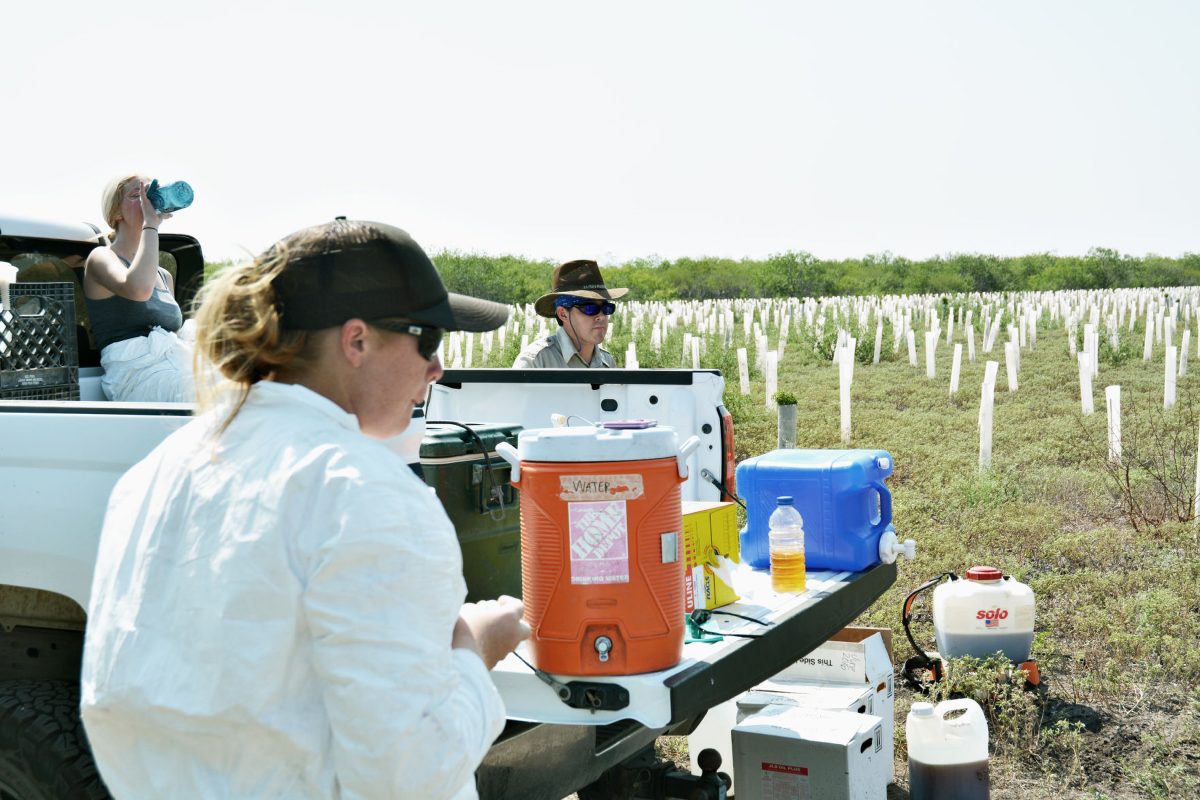
LOS FRESNOS — When you plant a new garden, especially one sprawling across 34 acres, your work is just beginning.
Six months after planting 39,000 native species at Laguna Atascosa National Wildlife Refuge using an innovative tree tube protector for each individual plant, U.S. Fish and Wildlife Service experts were back last week for maintenance.
The three-foot tree protectors, for the most part, are still standing tall in row after row despite the Rio Grande Valley’s fierce winds.
More importantly, the survival rate for the native plants in this attempt to restore the native Tamaulipan thorn scrub habitat favored by endangered ocelots is phenomenal.
“Now we’re at six months and we’re at 92 percent, and that’s through the summer months,” said Kim Wahl, a plant biologist with USFWS who is based at the Lower Rio Grande Valley National Wildlife Refuge. “So we only lost a small amount during those summer months that we had with very little rainfall out here.”
In a testament to the power of new life, some of the plants, like the crucita, or blue mistflower, are bursting out above the top of the tree tubes.
“These that are like a little puffball up out of the top, most of them are crucita,” Wahl said. “When you go up to them, you’re going to notice that they’ve been chomped off, they’ve been eaten back and they’re getting some deer-browse on them.
“But the ones that are maybe four or five really thin stems coming out the top, is the Wright’s acacia and it is really thorny,” she said. “Of all that we planted, it’s the tallest one that’s out here because it’s not getting chomped back.”
Lots of work
As labor-intensive as putting tree tubes over tens of thousands of seedlings might be, the work of rodents, rabbits, deer and nilgai never ceases, and it’s the only way to ensure the plants have a chance to obtain a toe-hold on survival.
“We’ve shown that without using some of these methods we sometimes only get 20 percent survival at this point” of six months, said Boyd Blihovde, refuge manager at Laguna Atascosa. “We’ve had total failure in some fields.”
Blihovde pointed out factors like the common drought conditions which occur in summer in the Valley can’t be controlled.
But he feels the tree tubes are a crucial tool in providing a sheltered beginning for seedlings, blocking the harsh sun and keeping humidity levels higher inside the tubes — as well as protecting them from browsers.
“It keeps the ungulates, the deer and other animals, from coming in and munching on the poor things while they’re at a vulnerable stage,” he added.
Time to spray
Last week, Wahl, Eric Verberder and Leah Chelsky of USFWS were suited up in white protective gear since their gardening chores involved spraying herbicide on rogue mesquite trees growing outside the tree protectors.
Even though mesquite is a native, Wahl said they want to keep the plant species in the 34-acre plot proportional. Also, she said, left on their own, the mesquite would soon make it impossible to maneuver equipment up and down the rows.
“Although mesquite is part of the native habitat, we need to keep them from becoming too dominant,” she said. “So we’re going through and spraying the root sprouts to kill them to get the number back down to what it should be.
“What we’re targeting is only having about 50 mesquite per acre,” Wahl said. “Right now, we’d be looking at about a thousand per acre right here.”
Among the species planted at the Laguna Atascosa plot were snake eyes or devil queen, Texas torchwood, crucita, trixis or American threefold, lantana, Berlandier croton and Manzanita, or Barbados cherry.
What’s next?
The next move is to pull out the tree tubes in two or three months, and re-purpose them at an adjacent 34-acre plot at Laguna Atascosa to rebuild more thorn scrub habitat.
“It was a huge undertaking,” Wahl conceded.
Wahl said this, the second plot to use the tree protectors, provided valuable insight into installation techniques and positioning.
For example, the first plot used bamboo stakes to pin down the tree tubes, but this one used Fiberglas stakes because they could be pushed deeper to help keep the protectors upright in the wind.
“And I just learned a little bit more last week that we have to position the stakes in a downwind direction,” she said. “We put a lot of these on wrong and we could have been even that much more successful if we would have done the installation properly.”
Between October and March, approximately 275 acres in Cameron and Hidalgo counties were planted with native seedlings to restore the Valley’s original thorn scrub habitat. On most of that acreage, however, the tree protectors were not employed.
“We learned a lot through this site,” Wahl said.





